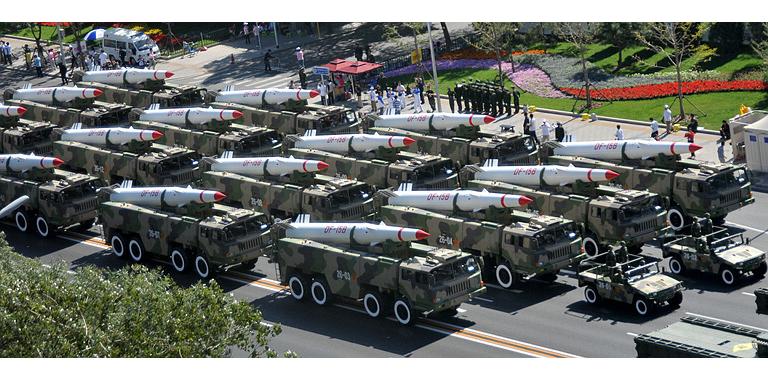
Economic Implications of China’s 5th Generation Leadership
December 24, 2010
Spinning the Wheel: Policy Implications of the Dalai Lama’s Reincarnation
January 30, 2011By: Mark Stokes |
Recent comments by Pacific Command (PACOM) Commander Admiral Robert Willard regarding China’s anti-ship ballistic missile (ASBM) program have attracted considerable media attention. As the world focuses on what indeed is an interesting new capability, China’s space and missile industry is offering hints of programs beyond a basic ASBM.
The Chinese Society of Astronautics recently honored three senior aerospace system designers for significant contributions to national defense. One of China’s most accomplished senior conventional ballistic missile designers is a gifted, relatively young, gentle mother of one – Zhu Xuejun [ç¥å¦å†›]. Born in December 1962, Ms. Zhu graduated from the National University of Defense Technology’s Automated Control Department in 1987 and earned a graduate degree from the China Aerospace Science and Technology Corporation’s (CASC) China Academy of Launch Technology (CALT, or First Academy) in missile systems design.
Ms. Zhu’s record of accomplishments is impressive and revealing of the types of advances that China is making in long range precision strike systems. Assigned to the CASC First Academy’s First Design Department, she was an original member of the design team for China’s first generation of conventional short range ballistic missiles, specifically the DF-15 (NATO: CSS-6). After technology management training in the United States in 1996, Ms. Zhu was assigned as senior designer for follow-on variants in 1999, most likely the DF-15A and DF-15B, which was showcased in the 2009 National Day parade. She also appears to be overseeing the development of the next generation variant, the DF-15C.
The CASC First Academy’s DF-15 SRBM has long been the centerpiece of China’s coercive military strategy directed against Taiwan. With a decision made in 1988 to deploy ballistic missiles in a conventional role, the build-up began with establishment of a seed training group on August 1, 1991 that consisted of 11 junior and field grade officers under the leadership of then-Lieutenant Colonel Gao Jin [高津]. Working closely with the CASC First Academy design team and assembly factory personnel in Beijing, the group formed the core of China’s first SRBM brigade, the 96165 Unit based in Leping, Jiangxi Province. Most original DF-15 seed unit officers are emerging as the next generation of Second Artillery leadership. Major General Gao Jin now commands Southeast China’s 52 Base, the Second Artillery’s most powerful missile army. Senior Colonel Zhou Xiaolin [周晓林] was appointed as the fourth commander of the Leping brigade in 2010. He was formerly the brigade’s senior engineer, and an initial cadre involved in the establishment of the conventional missile force.
Looking toward the future, Ms. Zhu is at the cutting edge of some of the world’s most sophisticated long range precision strike systems. As lead engineer of a newly established CASC First Academy conventional weapon system business division [战术æ¦å™¨äº‹ä¸šéƒ¨], she serves as chief designer for CASC First Academy’s first conventional two-stage solid-fueled conventional ballistic missile. CASC First Academy’s two-staged conventional ballistic missile recently completed conceptual design flight tests. Existing SRBMs, such as the CASC’s DF-15 and CASIC 066 Base’s DF-11A, have a single solid rocket motor. A CASC First Academy missile system with two solid motors would be indicative of a competition with the China Aerospace Science and Industry Corporation’s (CASIC) Fourth Academy’s 1700-kilometer range DF-21C medium range ballistic missile (MRBM). Appearing to be near completion of the research and development phase, the DF-21D ASBM likely is a variant of the DF-21C modified to engage moving targets at sea, such as aircraft carriers.
Zhu Xuejia Source: China Space News
The China Astronautics Society also cites Ms. Zhu as serving as technical director for a maneuverable conventional missile system that remains in the atmosphere the entire range of its flight. As a type of hypersonic cruise vehicle, a system on a depressed ballistic trajectory with a maneuverable post-boost vehicle likely would complicate detection and engagement by sea-based missile defense interceptors, such as the Standard Missile-3 (SM-3).
As a final note, the September 2010 China Astronautics Society article also highlights the accomplishments of Fan Shiwei [樊士伟], a leading figure in the top level design and development of China’s space-based sensor architecture. As Director of the PLA General Armaments Department (GAD) Aerospace Bureau General Design Research Center [æ€»è£…å¤‡éƒ¨èˆªå¤©è£…å¤‡å±€ç ”å‘ä¸å¿ƒ], Fan likely has played a leading role in the design and operational requirements development process for the space-based surveillance system that would support an ASBM.
Mark Stokes is the Executive Director of the Project 2049 Institute





